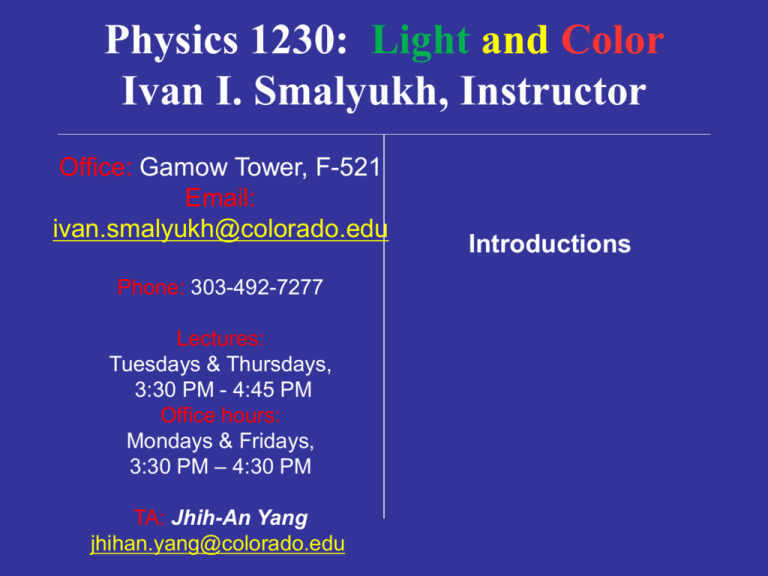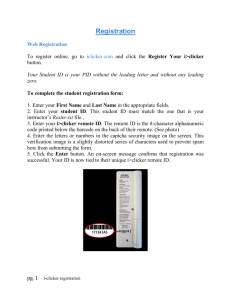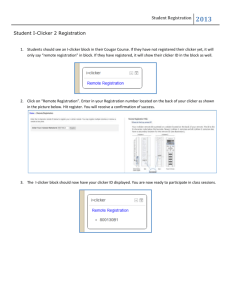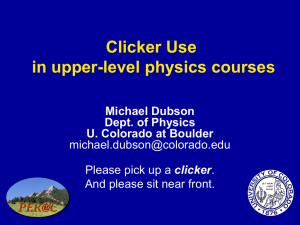Class 1 - University of Colorado Boulder
advertisement

Physics 1230: Light and Color Ivan I. Smalyukh, Instructor Office: Gamow Tower, F-521 Email: ivan.smalyukh@colorado.edu Phone: 303-492-7277 Lectures: Tuesdays & Thursdays, 3:30 PM - 4:45 PM Office hours: Mondays & Fridays, 3:30 PM – 4:30 PM TA: Jhih-An Yang jhihan.yang@colorado.edu Introductions Physics 1230: Light and Color Day 1: Why are we here…? What’s this class about ? What do we need to do ? How do we plan on doing it ? Start learning about light properties. “Invisible Rod” demonstration 2 Is this possible??? 3 http://www.youtube.com/watch?v=JKPVQal851U http://www.youtube.com/watch?v=JKPVQal851U Today • • • • Introduction Why the class is as it is Structure of the class Lots of information .. Posted on the Web. – You are responsible for the information on the website – Primary resource for class (WILL BE!): http://www.colorado.edu/physics/phys1230 • First discussion of light properties. 4 Let’s go to the website! http://www.colorado.edu/physics/phys1230 • How the course works • Major topics: Homework and exams, your grade, the book, our first homework on CULearn, and iClickers. 5 What will be tested in this class? How can I get a good grade? Ability to: Memorize "Understand" new Deeper understanding: Be able to new facts concepts at a figure out new things using concepts and mi nim al level definitions Percent of grade: 25% 25% 50% (only 15% uses math) Lecture Notes • Short and extended versions of the lecture notes; • PPT or PDF files available for downloading from the course web page 7 iClickers The iClicker is the University of Colorado Standard for Clickers. We will use the iClicker in most classes. 8 Using iClickers • • • • • Everyday: swap clicker code to DC Wait for 1st clicker question to open Hold down On/Off Switch 4 seconds Flashing blue light: hit D C Type in Answer. you’re set for rest of class period • DO NOT TURN OFF CLICKER FOR CLASS (o.w. repeat above for any new clicker question) 9 Example of a clicker question Do you have your clicker here today? a) yes b) no c) 1492 d) The Gettysburg Address e) I think so, Brain, but where are we going to get a trained octopus this time of night? 10 Have you used clickers in a prior class? • A – • B – Yes No You are NOT locked in to your first choice. Final answer entered will be the one accepted/graded. 11 Your iClicker Put your name and contact information on your clicker so if you lose it, there is a chance it will be returned. You can put your contact information on a piece of tape on the clicker if you plan to return the iClicker in the future 12 Clicker grading • Performance points for each question answered • Additional points for right answer sometimes 13 Survey to be answered by clickers 1. What is your background for light and color? Choose the one which best describes your science background a) I have had no physics in high school or college b) I have had physics in high school but not in college c) I have taken a physics course OR a psychology course at the college level d) I have taken more than one physics or psychology courses (high school and/or college level) e) I am a science major Survey to be answered by clickers 2. Why did you take this course? Give the answer which best describes your reason. a) Because of requirements by the university b) Because it was recommended to me c) Because it looked easy d) Because it looked interesting e) I don't know why What is your math background? a) b) c) d) Taken up to some level of calculus Taken up to trigonometry Taken some algebra. Something else. 16 The textbook • Not required but strongly recommended (HW and reading assignments) • Not very good, outdated, but there is no better one; 17 Equations in the course! • Much more than in “Sound & Music” • Less than in Graduate quantum mechanics • Derivations • Scientific notations… • • I often hear “I lost my ability to dance”, “Equations are very hard to understand”, “I cannot sleep…” I also hear “This is a trivial course,” “I have learned all of this in high school…” 18 Scientific notation and metric system • Powers of 10 give a shorthand notation for very large numbers. • • • • 103 = 1000 102 = 100 10 1 = 10 100 = 1 • Or very small numbers • 10-1 = 0.1 • 10-2 = 0.01 • 10-3 = 0.001 • Scientists don't use feet or miles to indicate distances • They use – meters (m) • 1 meter = 39.4 inches – kilometers (km) • 1 km = 1000 m = 0.625 mi – centimeters (cm) • 1 cm = 10-2 m = 0.394 inches – millimeters (mm) • 1 mm = 10-3 m – nanometers (nm) • 1 nm = 10-9 m Example: dividing numbers in scientific notations The mathematical description: Coulomb’s Force Law: Q Depends on the charges 1 qQ FqQ r rˆ 2 4 0 r r distance q Constants of nature. What is the force that q feels from Q? 20 Another way to think about it: 1 qQ rˆ Coulomb’s Force Law: FqQ r 2 4 0 r Which is another way to write this force law? 1 Q A) FqQ r q 4 r 2 rˆ 0 q 1 Q rˆ B) FqQ r 2 2 r 4 0 r 1 qQ rˆ C) FqQ r 2 4 0 r D) None of these 21 I will help as much as I can But, if you are taking this course: • you need to have an appropriate preparation background; • You need to be highly motivated and prepared to work hard; • May take much more or much less time than your other courses; • Might be also easy for you or you might have learned it already – understand that others might have a different preparation 22 Physics Helproom! • Open for questions • Introduce yourself to neighbors • A short field trip…to the Physics Helproom. 23






